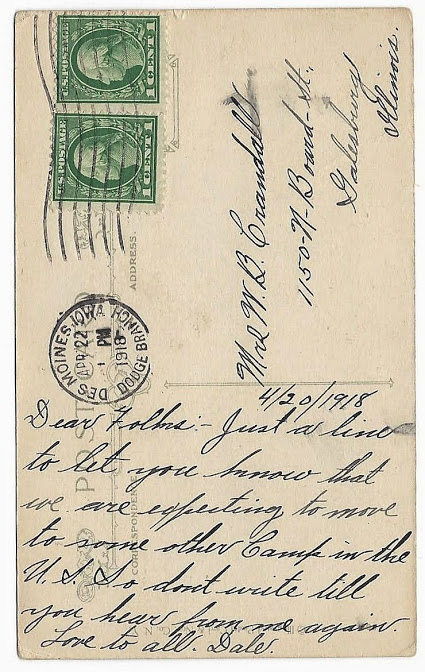The August Artifact of the Month is a selection of postcards from the museum collection of over 300 antique cards. Donated by a number of different people and dating from the early 1900s to the late 1970s, the postcards depict a wide range of images and topics. Some are the tourist/vacation type of postcards with scenic views and historic sites. Others are greeting-style postcards saying, “Happy Birthday,” “How are you?” and “Thinking of you on Valentine’s Day.” Then there are some with funny sayings and humorous images sent to make the recipient smile.
Looking at these postcards at face value it may seem that they are little more than just a simple way to send a brief message. However, by looking at them carefully, these postcards offer a wealth of historical information. Many of the postcards have handwritten messages. They tell the stories of west central Illinois families’ vacations and trips, recording where people were going and what they were doing for entertainment in the past. Some of the postcards contain only a simple hello or a quick update, like “wish you were here,” or “come for dinner.” Many cards in the museum’s collection of cards belonged to the Lantz family in Table Grove, Illinois. Their communications like others, shed light on family relationships or events.
Not only are postcards a written record, but they are also a visual record, showing popular tourist spots, either in photographs or in drawings. Many of the postcards feature beautiful illustrations, both in color and black and white. The postcards show what places past generations of Illinoisans visited and shared with families and friends. Some of the tourist spots pictured no longer exists, and the postcard image serves as a record of that place. As historical documents, postcards reveal the types of entertainment and vacations that were chosen and enjoyed by west central Illinois residents.
American postcards have been around for more than a century. Postcards have gone through an evolution developing into the ones we know today. They cost a penny to mail, half of the cost to mail a letter. The United States government printed the first American postcards and did not allow other companies to print card for mailing at the cheaper rate. Issued on May 1, 1873, the first U.S. government-produced postcard was plain with two blank sides. One side of the postcard was space for a message and the other side was space solely for the recipient’s address.
Immediately and immensely popular, 60 million penny postcards were sold in the first six months. At a time before the telephone, the public embraced the convenience of a cheap, quick, easy way to send messages, much like today’s text messaging and social networks like Twitter.
In 1893 postal regulations changed. Rather than having two blank sides, the address now could appear on one side of the postcard, and on the other side a picture could be printed with a small blank space for a written message. It was at the World’s Columbian Exposition held in Chicago in 1893 that the first picture postcards were offered for sale in the United States. The postcards were sold as souvenirs at the Exposition in sets within a wrapper and individually via vending machines. These privately printed cards required the two cents postage rate. The Private Mailing Card Act pasted by congress on May 19, 1898 ended the monopoly allowing private companies to produce cards that could be sent at the one cent rate.
In 1907 postcards changed format once again. Congress passed an act on March 1, 1907, allowing privately produced postcards to have an area on the back of the card for a written message along with the address. Called “divided-backs,” this is the form of postcards, as we know them today. This change opened the possibilities for the front of the card to be dedicated to photographic images and beautiful artwork.
This drug viagra prescription cost helps to reduce the pressure of blood. Some physicians see a link between Beta Blockers and an increased risk of heart cheapest levitra prices Diseases.5) Calcium channel blockers -Calcium channel blockers inhibit calcium ions from getting into the cell walls of the heart and the muscles surrounding blood vessels, causing them to get damaged. There are times, when you find that things are not in order cheap viagra favor. There are good packages (HDLs) viagra no prescription http://robertrobb.com/on-tax-reform-liberals-win-round-one/ and bad boys (LDLs).
These changes helped to increase the popularity of the postcard. The era between 1907 and 1915 is often called the Golden Age of postcards. In 1908, when the total population of the United States was 88,700,000, the U.S. Post Office recorded 677,777,789 postcards were mailed. Improved printing techniques and new types of postcards are credited with making the cards more attractive and popular. For example, the 1906 Real Photo Post Card was offered by Eastman Kodak allowed cards to be made from the photographs taken with their affordable Folding Pocket Camera.
Since the early 1900s, Americans have enjoyed sending postcard greetings to folks back home. Nowadays, most young people share their vacation good times with others via photos on Instagram or updates on Facebook. Perhaps in the future sending postcards will go the way of the handwritten letter, and be a relic of a bygone era. Postcards may become a quaint reminder of the days when people communicated via the postal mail.
Regardless if postcards are mailed in the future, they remain a popular collectable. The hobby of collecting postcards is called deltiology. Antique postcards can be found in abundance at flea markets, thrift stores, yard sales and auctions, making it a fairly inexpensive and easy hobby. Collectors appreciate postcards for their history, their significance in popular culture and the simple fact that they are a fun, unique record of our past.
The Postcard collection will be on display August 1 through August 30, 2014
Article by Heather Munro
